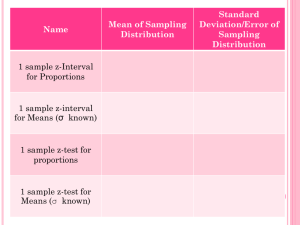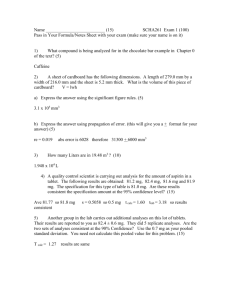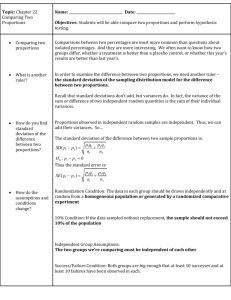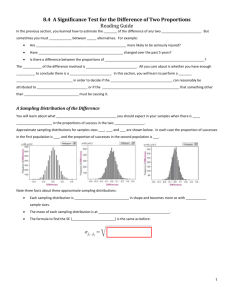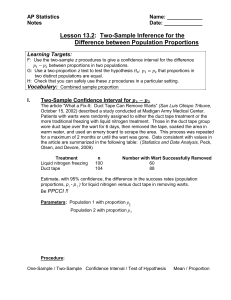Chapter 22 Powerpoint - Peacock
advertisement
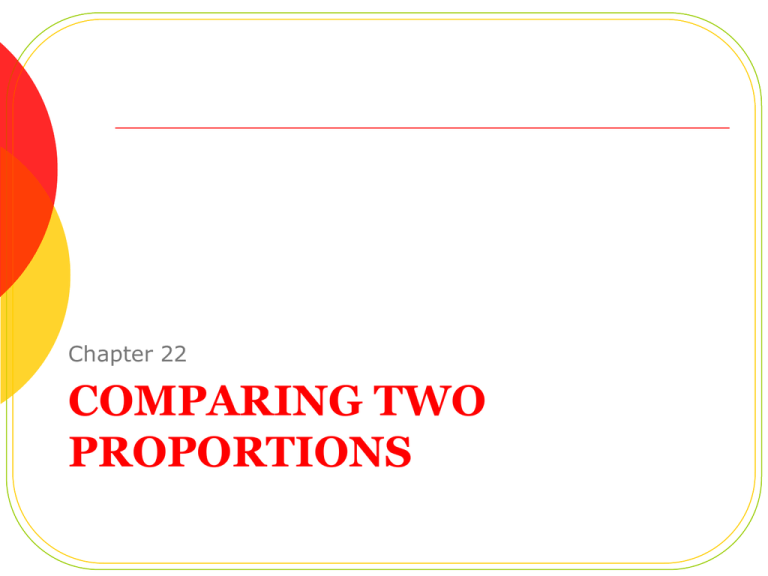
Chapter 22 COMPARING TWO PROPORTIONS Objectives Sampling distribution of the difference between two proportions 2-proportion z-interval Pooling 2-proportion z-test Comparing Two Proportions Comparisons between two percentages are much more common than questions about isolated percentages. And they are more interesting. We often want to know how two groups differ, whether a treatment is better than a placebo control, or whether this year’s results are better than last year’s. Another Ruler In order to examine the difference between two proportions, we need another ruler—the standard deviation of the sampling distribution model for the difference between two proportions. Recall that standard deviations don’t add, but variances do. In fact, the variance of the sum or difference of two independent random quantities is the sum of their individual variances. The Standard Deviation of the Difference Between Two Proportions Proportions observed in independent random samples are independent. Thus, we can add their variances. So… The standard deviation of the difference between two sample proportions is SD pˆ1 pˆ 2 p1q1 p2 q2 n1 n2 Thus, the standard error is SE pˆ1 pˆ 2 pˆ1qˆ1 pˆ 2 qˆ2 n1 n2 Assumptions and Conditions Independence Assumptions: Randomization Condition: The data in each group should be drawn independently and at random from a homogeneous population or generated by a randomized comparative experiment. The 10% Condition: If the data are sampled without replacement, the sample should not exceed 10% of the population. Independent Groups Assumption: The two groups we’re comparing must be independent of each other. Assumptions and Conditions Sample Size Condition: Each of the groups must be big enough… Success/Failure Condition: Both groups are big enough that at least 10 successes and at least 10 failures have been observed in each. The Sampling Distribution We already know that for large enough samples, each of our proportions has an approximately Normal sampling distribution. The same is true of their difference. The Sampling Distribution Provided that the sampled values are independent, the samples are independent, and the samples sizes are large enough, the sampling distribution of pˆ1 pˆ 2 is modeled by a Normal model with Mean: p1 p2 Standard deviation: SD pˆ1 pˆ 2 p1q1 p2 q2 n1 n2 The Sampling Distribution The approximately normal sampling distribution for ( p̂ 1 – p̂2): Two-Proportion z-Interval When the conditions are met, we are ready to find the confidence interval for the difference of two proportions: The confidence interval is ˆ ˆ p1 p2 z SE pˆ1 pˆ 2 where SE pˆ1 pˆ 2 pˆ1qˆ1 pˆ 2 qˆ2 n1 n2 The critical value z* depends on the particular confidence level, C, that you specify. Example: 2-Proportion z-Interval A recent study of 1000 randomly chosen residents in each of two randomly selected states indicated that the percent of people living in those states who were born in foreign countries was 6.5% for State A and 1.7% for State B. Find a 99% confidence interval for the difference between the proportions of foreignborn residents for these two states. Procedure: 2-Proportion z-Interval 1) Check Conditions 1) 2) 3) 4) 2) Independence Randomization 10% condition Success/Failure Calculation Confidence Interval pˆ1 pˆ 2 z SE pˆ1 pˆ 2 3) Conclusion o In context SE pˆ1 pˆ 2 pˆ1qˆ1 pˆ 2 qˆ2 n1 n2 Solution 1) Check Conditions 1) 2) 3) 4) Independence: Groups from different randomly selected states should be independent. Randomization: Each sample was drawn randomly from its respective state. 10% condition: Reasonable that the population of both states is greater than 10,000. Success/Failure: nA pˆ A 1000(.065) 65 10 nB pˆ B 1000(.017) 17 10 nAqˆ A 1000(.935) 935 10 nB qˆ B 1000(.983) 983 10 Solution 2) Calculate 99% Confidence Interval pˆ1 pˆ 2 z SE pˆ1 pˆ 2 pˆ A .065, pˆ B .017 and pˆ A pˆ B (.065 .017) .048 z * 2.576 SE pˆ1 pˆ 2 pˆ1qˆ1 pˆ 2 qˆ2 (.065)(.935) (.017)(.983) .0088 n1 n2 1000 1000 me 2.576(.0088) .0227 99% CI: .048 .0227 or (.0253,.0707) Solution Conclusion I am 99% confident that the percent difference of foreign-born residents for states A and B is between 2.5% and 7.1%. Your Turn Suppose the AGA would like to compare the proportion of homes heated by gas in the South with the corresponding proportion in the North. AGA selected a random sample of 60 homes located in the South and found that 34 of the homes use gas for heating fuel. AGA also randomly sampled 80 homes in the North and found 42 used gas for heating. Construct a 90% confidence interval for the difference between the proportions of Southern homes and Northern homes which are heated by gas. Solution 1) Check Conditions 1) 2) 3) 4) Independence: Samples from different parts of the country (north and south) should be independent. Randomization: Each sample was drawn randomly. 10% condition: Reasonable that the population in the North is greater than 800 and the population in the South is greater than 600. Success/Failure: 42 North : pˆ N .525 80 34 South : pˆ S .567 60 nN pˆ N 80(.525) 42 10 nS pˆ S 60(.567) 34 10 nN qˆ N 80(.475) 38 10 nS qˆS 60(.433) 26 10 Solution 2) Calculate 99% Confidence Interval pˆ1 pˆ 2 z SE pˆ1 pˆ 2 pˆ S .567, pˆ N .525 and pˆ S pˆ N (.567 .525) .042 z * 1.645 SE pˆ1 pˆ 2 pˆ1qˆ1 pˆ 2 qˆ2 (.567)(.433) (.525)(.475) .0849 n1 n2 60 80 me 1.645(.0849) .140 90% CI: .042 .14 or (.098,.182) Solution Conclusion I am 90% confident that the percent difference of homes in the South and the North is between 9.8% and 18.2%. Because the 90% confidence interval contains the value 0, our samples have not indicated a real difference between the proportions of Southern homes and Northern homes which are heated by gas. The proportion of Southern homes could be smaller than the corresponding proportion for Northern homes by as much as 9.8%, or the proportion of Southern homes could exceed the proportion for Northern homes by as much as 18.2%. TI-84: 2-Proportion z-Interval Press STAT key, choose TESTS, and then choose B: 2-PropZInterval… Adjust the settings; x1: the number selected sample 1 n1: sample 1 sample size x2: the number selected sample 2 n2: sample 2 sample size C-level: confidence level Select “Calculate” Example – Using the TI-84 How much does the cholesterol-lowering drug Gemfibrozil help reduce the risk of heart attack? We compare the incidence of heart attack over a 5-year period for two random samples of middle-aged men taking either a placebo or the drug. Find a 90% Confidence Interval for the decease in the percentage of middle-aged men having heart attacks on the cholesterol-lowering drug. H. attack n Drug 56 2051 2.73% Placebo 84 2030 4.14% Solution 90% Confidence Interval (.0047, .02345) Conclusion We are 90% confident that the percent difference of middle-aged men who suffer a heart attack is 0.47% to 2.3% lower when taking the cholesterollowering drug. TWO PROPORTION Z-TEST Everyone into the Pool The typical hypothesis test for the difference in two proportions is the one of no difference. In symbols, H0: p1 – p2 = 0. Since we are hypothesizing that there is no difference between the two proportions, that means that the standard deviations for each proportion are the same. Since this is the case, we combine (pool) the counts to get one overall proportion. Everyone into the Pool The pooled proportion is pˆ pooled Success1 Success2 n1 n2 where Success1 n1 pˆ1 and Success2 n2 pˆ 2 If the numbers of successes are not whole numbers, round them first. (This is the only time you should round values in the middle of a calculation.) Everyone into the Pool We then put this pooled value into the formula, substituting it for both sample proportions in the standard error formula: SE pooled pˆ1 pˆ 2 pˆ pooled qˆ pooled n1 pˆ pooled qˆ pooled n2 Compared to What? We’ll reject our null hypothesis if we see a large enough difference in the two proportions. How can we decide whether the difference we see is large? Just compare it with its standard deviation. Unlike previous hypothesis testing situations, the null hypothesis doesn’t provide a standard deviation, so we’ll use a standard error (here, pooled). Two-Proportion z-Test The conditions for the two-proportion z-test are the same as for the two-proportion z-interval. We are testing the hypothesis H0: p1 – p2 = 0, or, equivalently, H0: p1 = p2. The alternative hypothesis is either; Ha: p1≠p2, Ha: p1<p2, or Ha: p1>p2. Because we hypothesize that the proportions are equal, we pool them to find pˆ pooled Success1 Success2 n1 n2 Two-Proportion z-Test We use the pooled value to estimate the standard error: SE pooled pˆ1 pˆ 2 pˆ pooled qˆ pooled n1 pˆ pooled qˆ pooled n2 Now we find the test statistic: ( pˆ1 pˆ 2 ) 0 z SE pooled ( pˆ1 pˆ 2 ) When the conditions are met and the null hypothesis is true, this statistic follows the standard Normal model, so we can use that model to obtain a P-value. Procedure: 2-Proportion z-Test 1. 2. 3. Check conditions Hypothesis Test Statistic pˆ pooled 4. 5. Z test statistic Success1 Success2 n1 n2 P-value Conclusion ( pˆ1 pˆ 2 ) 0 z SE pooled ( pˆ1 pˆ 2 ) SE pooled pˆ1 pˆ 2 pˆ pooled qˆ pooled n1 pˆ pooled qˆ pooled n2 Example: 2-Proportion z-Test A researcher wants to know whether there is a difference in AP-Statistics exam failure rates between rural and suburban students. She randomly selects 107 rural students and 143 suburban students who took the exam. Thirty rural students failed to pass their exam, while 45 suburban students failed the exam. Is there a significant difference in failure rates for these groups? Solution 1) Check Conditions 1. 2. 3. 4. Independence: Rural and Suburban student groups are independent. Randomization: Samples were randomly drawn. 10% Condition: It is reasonable to believe that the population of rural exam takers is greater than 1070 and the population of suburban exam takers is greater than 1430. Success/Failures: success1=30>10 success2=45>10 failure1=(107-30)=77>10 failure2=(143-45)=98>10 Solution 2) Hypothesis Null hypothesis – H0: pR=pS (There is no difference in failure rates.) Alternative hypothesis – Ha: pR≠pS (There is a difference in failure rates.) Solution Test Statistic 3) pˆ R 30 45 .280, pˆ S .315, and pˆ R pˆ S .280 .315 .035 107 143 pˆ pooled Success1 Success2 30 45 .3 n1 n2 107 143 SE pooled pˆ1 pˆ 2 pˆ pooled qˆ pooled n1 pˆ pooled qˆ pooled n2 1 1 (.3)(.7) .059 107 143 ( pˆ1 pˆ 2 ) 0 .035 0 z .59 SE pooled ( pˆ1 pˆ 2 ) .059 Solution 4) P-value 5) z = -.59 and a two-tailed test P-value = 2P(z > .59) = 2(.2776) P-value = .5552 Conclusion The P-value .5552 is too high, thus we fail to reject the null hypothesis. There is insufficient evidence to show a difference between the failure rates of rural and suburban students on the AP Statistics exam. Your Turn: 2-Proportion z-Test In recent years there has been a trend toward both parents working outside the home. Do working mothers experience the same burdens and family pressures as their spouses? A popular belief is that the proportion of working mothers who feel they have enough spare time for themselves is significantly less than the corresponding proportion of working fathers. In order to test this claim, independent random samples of 100 working mothers and 100 working fathers were selected and their views on spare time for themselves were recorded. A summary of the data is given in the table below. Is the belief that the proportion of working mothers who feel they have enough spare time for themselves less than the corresponding proportion of working fathers supported at significance level α=.01 by the sample information? Number sampled Number who feel they have enough spare time Working Mothers Working Fathers 100 100 37 56 Solution 1) Check Conditions 1. 2. 3. 4. Independence: Samples were independent. Randomization: Samples were randomly drawn. 10% Condition: It is reasonable to believe that the population of mothers and fathers is greater than 1000. Success/Failures: success1=37>10 success2=56>10 failure1=(100-37)=63>10 failure2=(100-56)=44>10 Solution 2) Hypothesis Null hypothesis – H0: pM=pF (There is no difference between Mothers and Fathers who feel they have enough spare time for themselves.) Alternative hypothesis – Ha: pM<pF (The proportion of working mothers who feel they have enough spare time for themselves is less than the corresponding proportion of working fathers .) Solution 3) Test Statistic pˆ M 37 56 .37, pˆ F .56, and pˆ M pˆ F .37 .56 .19 100 100 pˆ pooled Success1 Success2 37 56 .465 n1 n2 100 100 SE pooled pˆ1 pˆ 2 pˆ pooled qˆ pooled n1 pˆ pooled qˆ pooled n2 1 1 (.465)(.535) .0705 100 100 ( pˆ1 pˆ 2 ) 0 .19 0 z 2.70 SE pooled ( pˆ1 pˆ 2 ) .0705 Solution 4) P-value 5) z = -2.70 and a left-tailed test P-value = P(z < -2.70) = .0035 P-value = .0035 Conclusion The p-value = .0035 is less than α = .01, thus we reject the null hypothesis. There is sufficient evidence at the 1% significance level to conclude that the proportion of working mothers who feel they have enough spare time for themselves is less than the corresponding proportion of working fathers. TI-84: 2-Proportion z-Test Press STAT key, choose TESTS, and then choose 6: 2-PropZTest… Adjust the settings; x1: n1: x2: n2: p1: the number selected sample 1 sample 1 sample size the number selected sample 2 sample 2 sample size select type of test (≠p2, <p2, >p2) Select “Calculate” Example Using TI-84 To market a new white wine, a winemaker decides to use two different advertising agencies, one operating in the east, one in the west. After the white wine has been on the market for 8 months, independent random samples of wine drinkers are taken from each of the two regions and questioned concerning their white wine preference. The numbers favoring the new brand are shown in the table. Is there evidence that the proportion of wine drinkers in the west who prefer the new wine is greater than the corresponding proportion of wine drinkers in the east. Test at the .02 significance level. Number sampled Number who prefer the new white wine East West 516 438 18 23 Solution H0:pW=pE Ha:pW>pE 2-PropZTest x1: n1: x2: n2: p1: 23 438 18 516 >p2 z = 1.338 and P-value = .0905 Conclusion The P-value .0905 is greater than α =.02, thus we fail to reject the null hypothesis. There is insufficient evidence at the .02 significance level to conclude that the proportion of wine drinkers in the west who prefer the new white wine is greater than the corresponding proportion of wine drinkers in the east. What Can Go Wrong? Don’t use two-sample proportion methods when the samples aren’t independent. Don’t apply inference methods when there was no randomization. These methods give wrong answers when the independence assumption is violated. Our data must come from representative random samples or from a properly randomized experiment. Don’t interpret a significant difference in proportions causally. Be careful not to jump to conclusions about causality. What have we learned? We’ve now looked at inference for the difference in two proportions. Perhaps the most important thing to remember is that the concepts and interpretations are essentially the same—only the mechanics have changed slightly. What have we learned? (cont.) Hypothesis tests and confidence intervals for the difference in two proportions are based on Normal models. Both require us to find the standard error of the difference in two proportions. We do that by adding the variances of the two sample proportions, assuming our two groups are independent. When we test a hypothesis that the two proportions are equal, we pool the sample data; for confidence intervals we don’t pool. Assignment Pg 519 – 522: #1 – 21 odd
